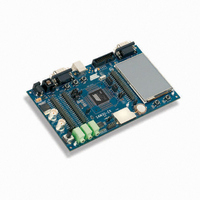ATSAM3U-EK Atmel, ATSAM3U-EK Datasheet - Page 339

ATSAM3U-EK
Manufacturer Part Number
ATSAM3U-EK
Description
KIT EVAL FOR AT91SAM3U CORTEX
Manufacturer
Atmel
Type
MCUr
Datasheets
1.ATSAM3U-EK.pdf
(2 pages)
2.ATSAM3U-EK.pdf
(61 pages)
3.ATSAM3U-EK.pdf
(1171 pages)
4.ATSAM3U-EK.pdf
(53 pages)
Specifications of ATSAM3U-EK
Contents
Board
Processor To Be Evaluated
SAM3U
Data Bus Width
32 bit
Interface Type
RS-232, USB
Operating Supply Voltage
3 V
Silicon Manufacturer
Atmel
Core Architecture
ARM
Core Sub-architecture
Cortex - M3
Silicon Core Number
SAM3U4E
Silicon Family Name
SAM3U
Kit Contents
Board CD Docs
Rohs Compliant
Yes
For Use With/related Products
AT91SAM3U
Lead Free Status / RoHS Status
Lead free / RoHS Compliant
Available stocks
Company
Part Number
Manufacturer
Quantity
Price
Company:
Part Number:
ATSAM3U-EK
Manufacturer:
Atmel
Quantity:
10
- ATSAM3U-EK PDF datasheet
- ATSAM3U-EK PDF datasheet #2
- ATSAM3U-EK PDF datasheet #3
- ATSAM3U-EK PDF datasheet #4
- Current page: 339 of 1171
- Download datasheet (25Mb)
24. Bus Matrix (MATRIX)
24.1
24.2
24.3
24.3.1
24.3.2
24.3.3
6430D–ATARM–25-Mar-11
Description
Memory Mapping
Special Bus Granting Techniques
No Default Master
Last Access Master
Fixed Default Master
Bus Matrix implements a multi-layer AHB, based on AHB-Lite protocol, that enables parallel
access paths between multiple AHB masters and slaves in a system, which increases the over-
all bandwidth. Bus Matrix interconnects 5 AHB Masters to 10 AHB Slaves. The normal latency to
connect a master to a slave is one cycle except for the default master of the accessed slave
which is connected directly (zero cycle latency).
The Bus Matrix user interface is compliant with
Chip Configuration User Interface with Registers that allow the Bus Matrix to support application
specific features.
Bus Matrix provides one decoder for every AHB Master Interface. The decoder offers each AHB
Master several memory mappings. In fact, depending on the product, each memory area may be
assigned to several slaves. Booting at the same address while using different AHB slaves (i.e.
internal ROM or internal Flash ) becomes possible.
The Bus Matrix user interface provides Master Remap Control Register (MATRIX_MRCR) that
allows to perform remap action for every master independently.
The Bus Matrix provides some speculative bus granting techniques in order to anticipate access
requests from some masters. This mechanism allows to reduce latency at first accesses of a
burst or single transfer. The bus granting mechanism allows to set a default master for every
slave.
At the end of the current access, if no other request is pending, the slave remains connected to
its associated default master. A slave can be associated with three kinds of default masters: no
default master, last access master and fixed default master.
At the end of the current access, if no other request is pending, the slave is disconnected from
all masters. No Default Master suits low power mode.
At the end of the current access, if no other request is pending, the slave remains connected to
the last master that performed an access request.
At the end of the current access, if no other request is pending, the slave connects to its fixed
default master. Unlike last access master, the fixed master doesn’t change unless the user mod-
ifies it by a software action (field FIXED_DEFMSTR of the related MATRIX_SCFG).
To change from one kind of default master to another, the Bus Matrix user interface provides the
Slave Configuration Registers, one for each slave, that allow to set a default master for each
slave. The Slave Configuration Register contains two fields:
DEFMSTR_TYPE and FIXED_DEFMSTR. The 2-bit DEFMSTR_TYPE field allows to choose
the default master type (no default, last access master, fixed default master) whereas the 4-bit
ARM
®
Advance Peripheral Bus and provides a
SAM3U Series
339
Related parts for ATSAM3U-EK
Image
Part Number
Description
Manufacturer
Datasheet
Request
R

Part Number:
Description:
AT91 ARM Thumb-based Microcontrollers
Manufacturer:
ATMEL [ATMEL Corporation]
Datasheet:

Part Number:
Description:
DEV KIT FOR AVR/AVR32
Manufacturer:
Atmel
Datasheet:

Part Number:
Description:
INTERVAL AND WIPE/WASH WIPER CONTROL IC WITH DELAY
Manufacturer:
ATMEL Corporation
Datasheet:

Part Number:
Description:
Low-Voltage Voice-Switched IC for Hands-Free Operation
Manufacturer:
ATMEL Corporation
Datasheet:

Part Number:
Description:
MONOLITHIC INTEGRATED FEATUREPHONE CIRCUIT
Manufacturer:
ATMEL Corporation
Datasheet:

Part Number:
Description:
AM-FM Receiver IC U4255BM-M
Manufacturer:
ATMEL Corporation
Datasheet:

Part Number:
Description:
Monolithic Integrated Feature Phone Circuit
Manufacturer:
ATMEL Corporation
Datasheet:

Part Number:
Description:
Multistandard Video-IF and Quasi Parallel Sound Processing
Manufacturer:
ATMEL Corporation
Datasheet:

Part Number:
Description:
High-performance EE PLD
Manufacturer:
ATMEL Corporation
Datasheet:

Part Number:
Description:
8-bit Flash Microcontroller
Manufacturer:
ATMEL Corporation
Datasheet:

Part Number:
Description:
2-Wire Serial EEPROM
Manufacturer:
ATMEL Corporation
Datasheet:











